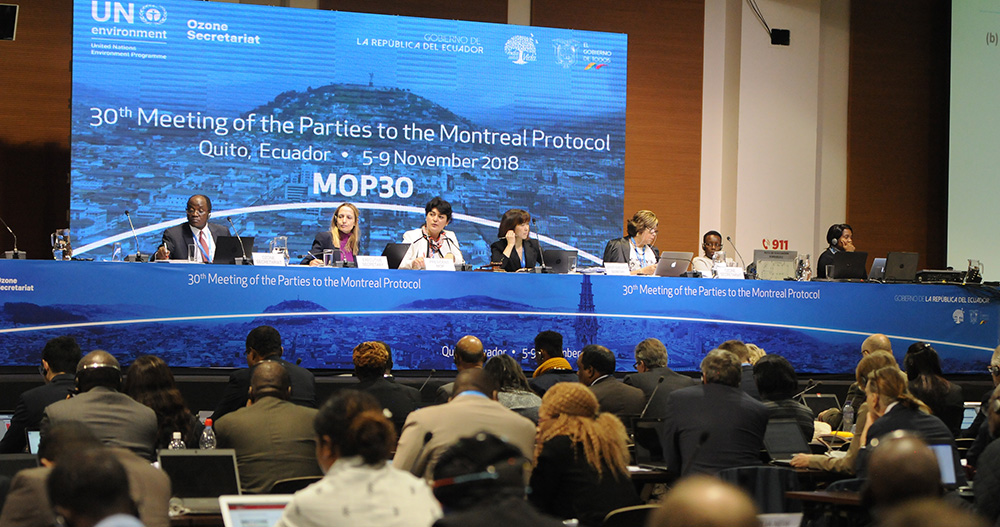Montreal Protocol Aims High in Quito to Avoid 1º C of Future Warming

Energy efficiency gains can double climate benefit from refrigerant switch
Quito, Ecuador, 10 November 2018 – Last night, at the conclusion of the annual meeting of the Montreal Protocol, the Parties took their strongest action yet to increase energy efficiency of cooling equipment in parallel with the mandated phase down of HFC refrigerants under the Kigali Amendment. This opens the door to doubling the climate benefits of the HFC phase down, according to the quadrennial Scientific Assessment of Ozone Depletion of the treaty’s Scientific Assessment Panel (SAP) released at the beginning of the meeting.
Two years ago, the Parties agreed to the Kigali Amendment to phase down HFCs, which has the potential to avoid up to 0.5ºC of warming by 2100 if implementation speeds up and Parties follow a leapfrog strategy that moves from the current refrigerants (HCFCs) directly into climate friendly alternatives, bypassing HFCs with high global warming potential.
“The stretch goal of this great treaty is to avoid up to 1ºC of warming by the end of the century from these combined strategies,” said Durwood Zaelke, President of the Institute for Governance & Sustainable Development, who participated in the Quito meeting.
In a formal decision taken late yesterday evening, the Parties noted that “improvements in the energy efficiency of refrigeration and air-conditioning equipment during the transition to low-global-warming-potential alternative refrigerants can potentially double the climate benefits of the Kigali Amendment”, and then authorized increasing funding for countries to implement energy efficiency. The decision directs the Multilateral Fund, the treaty’s dedicated funding mechanism, to explore cooperation and co-funding with other funds and financial institutions, such as the World Bank, which pledged $1 billion for the combined strategy in the runup to the Kigali Amendment.
The decision also directs the Multilateral Fund to “set up modalities for co-operation such as co-funding arrangements to maintain or enhance energy efficiency when phasing down HFCs, acknowledging that activities to assist Article 5 parties comply with their obligations under the Montreal Protocol will continue to be funded under the Multilateral Fund in accordance with its guidelines and decisions.”
The Africa Group and the Federated States of Micronesia assembled a strong group of allies to pursue the historic energy efficiency decision. Another decision on geoengineering, put forward by Micronesia, Morocco, Mali, and Nigeria, was withdrawn when it became clear that there would not be sufficient time to discuss it. The decision would have directed the Scientific Assessment Panel to continue studying the risk to the ozone layer from intentional injection of sulfates and other aerosols to cool the planet, a form of geoengineering that may represent the greatest remaining threat to the ozone layer. The Parties indicated they will submit another decision next year.
The quadrennial scientific assessment reported that there is now empirical evidence that the treaty’s efforts to cut chlorofluorocarbons (CFCs) and other ozone-depleting substances (ODS) was responsible for healing the stratospheric ozone layer and that the Antarctic ozone hole should recover by the 2060s. The level of stratospheric ozone depleting substances in the atmosphere is continuing to decline, and total ozone levels in the Antarctic are showing signs of recovery.
The Parties directed the SAP and Technology and Economic Assessment Panel (TEAP) to continue their investigation of unexpected and unreported emissions of CFC-11 first discussed at the Montreal Protocol’s mid-year working group meeting last July. A symposium on the issue is planned for March in Vienna.
“The Montreal Protocol gives the world hope that it’s still possible to slow climate change in time to avoid the looming existential threat of uncontrollable climate impacts,” Zaelke added. “Over the last three decades, this brilliant treaty has not only solved the first great threat to the global atmosphere—the destruction of the stratospheric ozone layer—but it’s also solved an amount of the climate problem that would have equaled the contribution of carbon dioxide today—more than half of all warming—with the Kigali Amendment and energy efficiency poised to add even more climate protection.”
The Montreal Protocol was signed in 1987, and is widely considered the world’s most successful international environmental treaty. The Parties took another two dozen decisions in Quito to advance the goals of their treaty. The meeting ended at 11:20 pm Friday 9 November.
The final decision on energy efficiency is here: Access of parties operating under paragraph 1 of Article 5 of the Montreal Protocol to energy-efficient technologies in the refrigeration, air-conditioning and heat-pump sectors
The draft decision on solar radiation management is here: The need to study the relationship between stratospheric ozone and proposed solar radiation management strategies